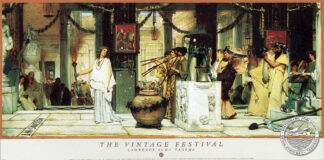ALMA-TADEMA, Lawrence

Born on 8th January 1836 in Dronrijp (Friesland, Netherlands) Lawrence Alma-Tadema became known as ‘the painter of the Victorian vision of the ancient world’. Punch magazine referred to him as ‘a marbellous painter’, due to his painting technique and subjects. He developed a fastidious technique, influenced by Jean-Léon Gérôme and suited to the illusional representation of surfaces such as marble. This combined with a flair for posing elegant females in archaeologically exact settings, which characterise the artist’s best works.
After visiting Italy in 1863, Alma-Tadema became fascinated with the ancient world of Pompeii and Egypt, and the next year won a gold medal at the Paris Salon for ‘Pastimes in ancient Egypt’. In 1864 he met influential Victorian art dealer Gambert, who put him under contract to produce a certain number of pictures each year. Gambert introduced his pictures to an English audience, and the artist settled permanently in London in 1870, when he was thirty-four.
Alma-Tadema quickly became one of the richest and most successful painters working in London. He transformed his two homes, (Townshend House) and (Tissot’s former studio at Grove End Road) into elaborate Victorian palaces, decorating rooms in various styles, including Pompeian, Moorish and Japanese. He painted at home, using his antiquarian collections as props, and his second wife Laura Eps, and his two daughters as models.
In spite of his fondness for Egyptian subjects, Alma-Tadema did not visit Egypt until the end of his career in 1902. He died on 28th June 1912 in Darmstadt, Hesse, Germany.
When once asked why he painted Egyptian scenes Alma-Tadema answered, “I don’t know, but it seems to me that anyone who studies history always returns to the cradle of civilization, Egypt“.
Showing the single result
-

THE VINTAGE FESTIVAL, (1871) – Lawrence Alma-Tadema – OFFSET PRINT – 46.4 x 94cm
$ 60.00 Add to cart
Showing the single result
